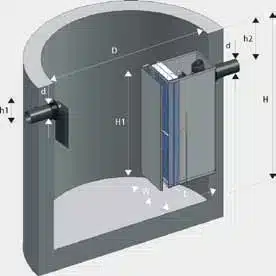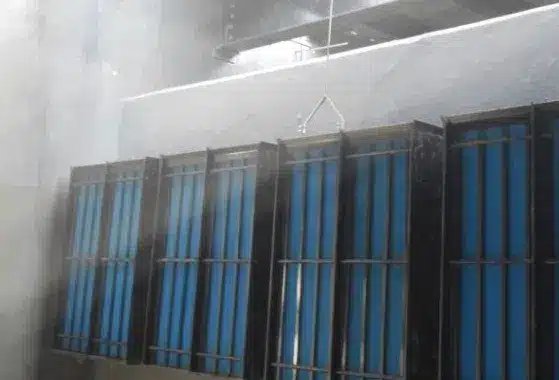Have you ever thought about the hidden world under Vermont’s beautiful landscapes? This state has a complex network of underground waterways and systems. They are key to keeping its environment clean. At the center of this is the Vermont Below Ground OWS, vital for managing water and protecting nature.
Vermont’s underground waterways create a complex network of hidden streams and flows. These channels shape the state’s landscape and affect its ecology in new ways. From deep underground rivers to advanced oil water separators, Vermont’s hidden water world is amazing.
Exploring Vermont’s underground water systems shows us why managing wastewater is crucial. We’ll see how septic tanks and leachfields work with nature. Also, we’ll look at the important role of oil water separators in keeping water clean and following laws.
Key Takeaways
- Vermont’s underground waterways form a complex network essential to the state’s ecology
- Below Ground OWS systems are crucial for managing wastewater and protecting the environment
- Onsite wastewater systems include septic tanks, distribution boxes, and leachfields
- Oil water separators play a vital role in preventing contamination and meeting regulations
- Proper maintenance of underground water systems is key to preserving Vermont’s natural beauty
Understanding Vermont’s Underground Waterways
Vermont’s landscape has a secret world beneath it. The state’s underground water systems are key to its ecology and hydrology. These hidden networks shape the area’s beauty and support many ecosystems.
Subterranean River Networks in Vermont
Vermont’s underground rivers form a complex network under the ground. These hidden paths link with streams and lakes above, making a vital water cycle. In some areas, limestone lets caves and tunnels form, adding to these networks.
Hidden Streams and Their Ecological Impact
Hidden streams in Vermont add to the state’s biodiversity. These underground rivers support unique water creatures and keep soil moist. They also control water temperature, vital for many plants and animals.
Importance of Concealed Drainage Systems
Concealed drainage systems in Vermont are crucial for managing water and preventing floods. They clean pollutants from runoff, keeping rivers and lakes clean. It’s vital to understand and care for these hidden networks to manage water well in the state.
The hidden wetlands of Vermont, linked to these systems, act as natural filters and homes. They support many plants and animals and control water during heavy rains or snowmelt. We must value these hidden water sources to keep Vermont’s nature safe.
Vermont Below Ground OWS: Function and Importance
Vermont’s hidden waterways need protection from pollution. Below Ground Oil Water Separators are key in keeping these areas safe. They handle wastewater well, keeping Vermont clean.
Oil Water Separator Basics
Below Ground OWS are devices that separate oil from water. They use gravity to split these substances by density. This stops oil from getting into Vermont’s water sources.
Advantages in Vermont
Below Ground Oil Water Separators bring many benefits to Vermont. They keep groundwater safe from oil pollution, which is important for the state’s beauty. These systems also help businesses follow strict environmental laws.
Meeting Environmental Standards
Vermont has tough laws to protect its water. Below Ground OWS clean wastewater before it reaches the environment. They remove almost all oil from water, keeping Vermont’s hidden waterways clean and safe for wildlife.
Using Below Ground Oil Water Separators shows Vermont businesses care for the environment. These systems are essential for responsible water management in the state.
Components of Below Ground Wastewater Systems in Vermont
Vermont’s below ground wastewater systems are key to managing subsurface water flows. They treat and dispose of wastewater safely, protecting the underground hydrology. Let’s look at the main parts of these important systems.
Septic Tanks
Septic tanks are the first step in treating wastewater. They are large containers under the ground. Here, wastewater stays long enough for solids to settle and oils to float on top. This process is crucial for keeping Vermont’s underground water clean.
Distribution Boxes and Leachfields
After treatment in the septic tank, wastewater goes to distribution boxes. These boxes split the water into many pipes that lead to the leachfield. Leachfields, or drain fields, are vital for Vermont’s subsurface water. They let the treated wastewater slowly soak into the soil, finishing the cleaning process.
Innovative/Alternative Systems
Vermont’s landscape sometimes needs special solutions. Innovative/Alternative (I/A) systems provide advanced treatment for tough sites. These systems can use smaller leachfields and work well with less separation from groundwater. I/A systems protect Vermont’s underground water in places where traditional systems won’t work.
Maintaining and Operating Below Ground OWS in Vermont
Keeping Vermont Below Ground OWS systems in good shape is key for their best performance and protecting our environment. Regular maintenance makes sure these systems work well, keeping our water safe.
To keep Below Ground Oil Water Separators working well, set up regular checks and cleanings. These inspections spot problems early. Clean the effluent filters often and pump septic tanks when needed to avoid overloading the system.
Using water wisely is important for these systems. Put in high-efficiency toilets and appliances to lessen the load on your OWS. Don’t flush things that can’t break down or pour harsh chemicals down drains, as they can mess up the separator’s balance.
For top-notch maintenance of Vermont Below Ground OWS, think about getting professional help. Companies like Freytech Inc. offer expert care to keep your system working right. They make sure your OWS keeps separating water effectively, making it last longer.
By following these tips and getting help when you need it, you can make sure your Below Ground Oil Water Separators keep protecting Vermont’s water resources.
These separators are crucial in storm water systems. They process runoff to meet the US EPA’s Clean Water Act standards. With effective oily water treatment, facilities protect the environment and dodge big fines.
Conclusion
Vermont Below Ground OWS systems are key to managing the state’s underground waterways and protecting its environment. They work hard under our feet, dealing with wastewater and keeping harmful substances out of water sources. By knowing their importance, people can see how these systems help keep Vermont beautiful.
Below ground wastewater systems have parts like septic tanks, distribution boxes, and leachfields. These parts make a network that cleans and filters water before it goes back into nature. Keeping these systems in good shape is important for them to work well. Regular checks and fixing problems on time help keep Vermont’s underground waterways clean and healthy.
With growing environmental worries, the role of Below Ground Oil Water Separators in Vermont is more important than ever. These devices are crucial in stopping oil and other pollutants from getting into the water. By using the latest separation tech and working with experts like Freytech Inc., Vermont is leading in managing water resources and protecting the environment. This keeps its beautiful landscapes safe for the future.










